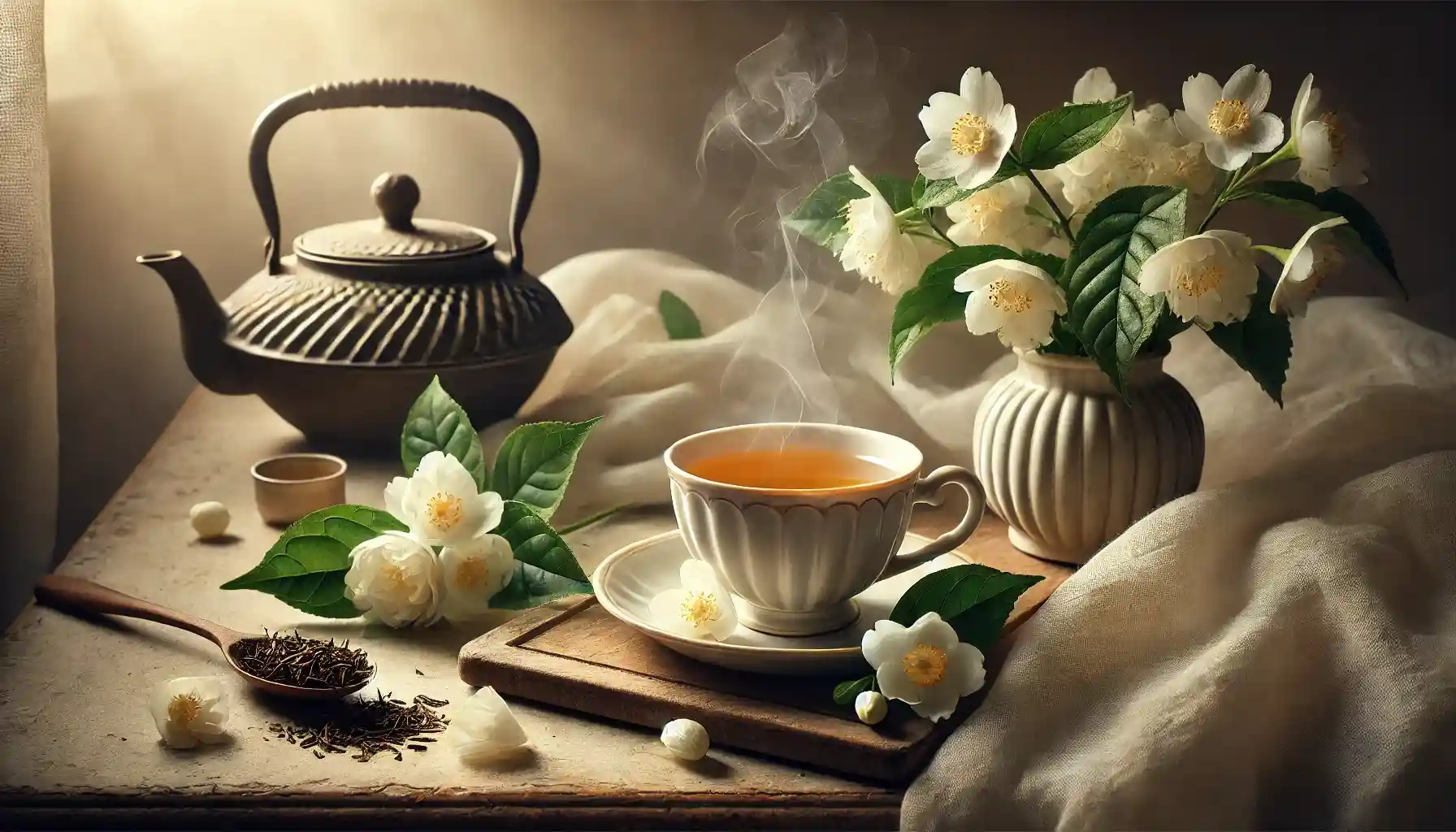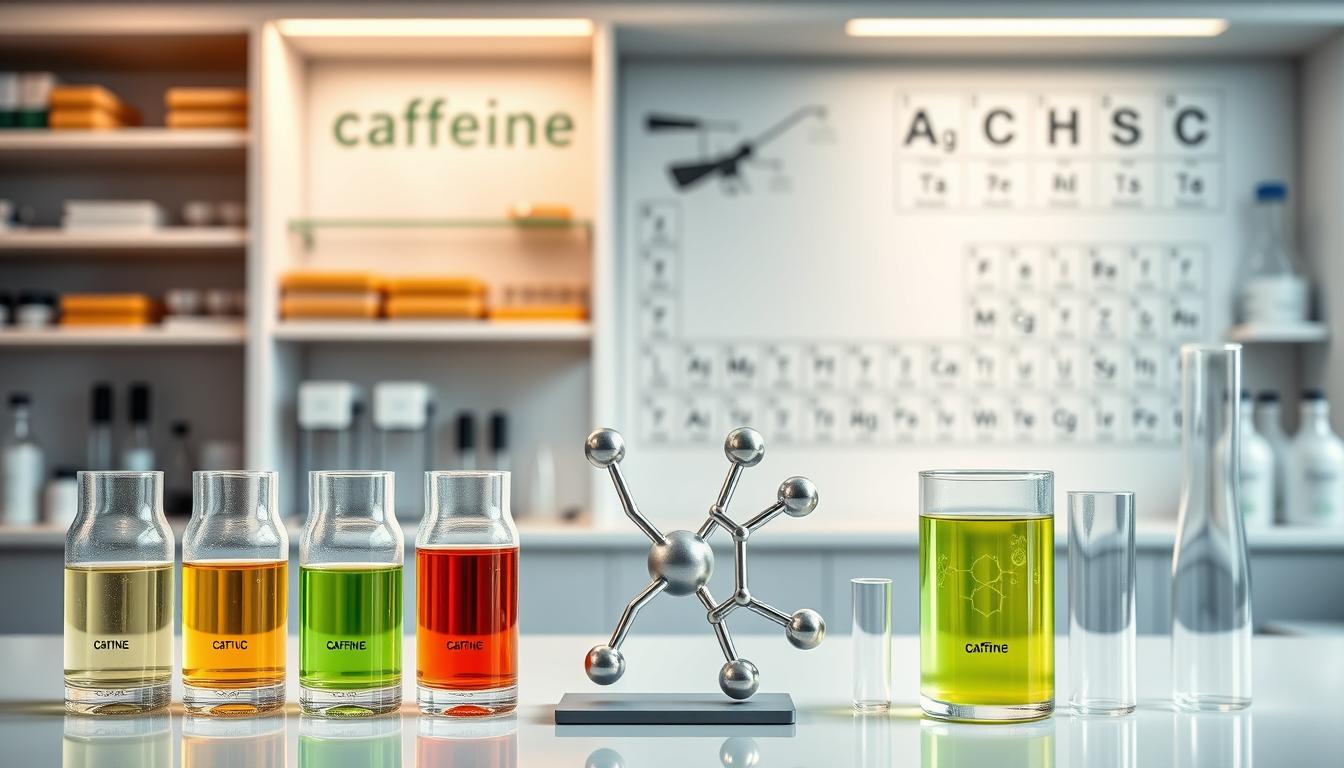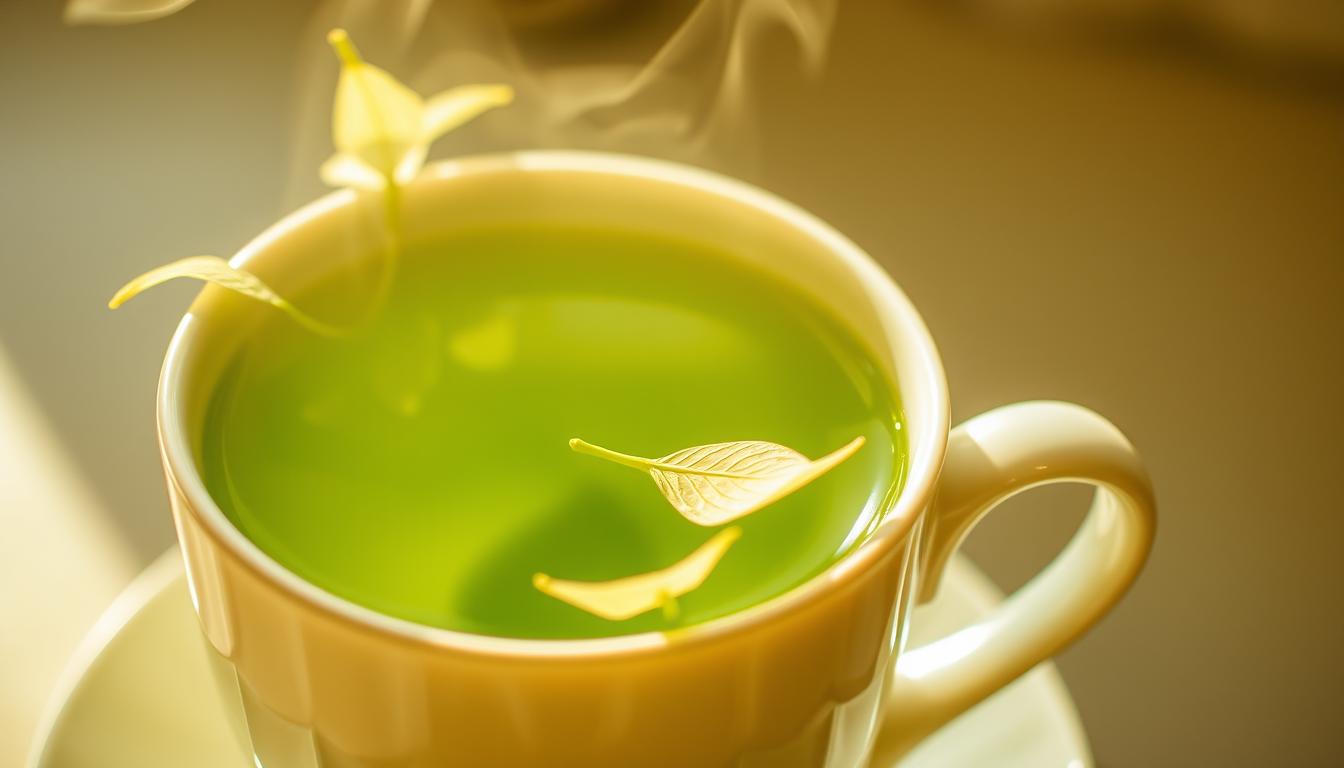Did you know that jasmine green tea has been enjoyed for over a thousand years? This aromatic blend combines the earthy notes of green tea with the sweet fragrance of jasmine blossoms. But one question often arises: how much caffeine does it contain?
Traditionally, this beverage is crafted by scenting high-quality green tea leaves with jasmine flowers. The result is a soothing drink with about 25 milligrams of caffeine per 8-ounce cup. This makes it a gentler option compared to coffee.
Originating in China, jasmine tea holds deep cultural significance. Its delicate flavor and calming aroma have made it a favorite worldwide. Whether you’re new to this blend or a long-time fan, understanding its composition and benefits can enhance your experience.
Key Takeaways
- Jasmine green tea contains around 25 milligrams of caffeine per cup.
- It’s made by scenting green tea leaves with jasmine flowers.
- This tea originated in China over a thousand years ago.
- Its flavor combines grassy green tea notes with sweet jasmine aromas.
- It’s a milder caffeine option compared to coffee.
Understanding Jasmine Tea Composition
Jasmine tea’s unique flavor comes from a centuries-old process of scenting tea leaves. This aromatic beverage begins as a basic tea made from high-quality tea leaves. The key to its distinct aroma lies in the use of jasmine flowers, which are carefully layered over the leaves during production.

History and Cultural Significance
Jasmine tea has deep roots in Chinese culture, dating back over a thousand years. The traditional method of scenting tea leaves with jasmine flowers was developed to enhance the natural flavors of the leaves. This process is not just about creating a delightful drink; it’s a reflection of ancient tea rituals and cultural heritage.
Traditional Scenting Process and Production
The production of jasmine tea involves a meticulous process. Fresh jasmine flowers are layered over tea leaves in a specific order during the evening. This allows the blossoms to release their potent scent, which infuses the leaves. The process is often repeated several times to achieve the desired strength and quality of the floral aroma.
Understanding the composition of jasmine tea helps appreciate its flavor and cultural significance. From the high-quality tea leaves to the fragrant jasmine flowers, every step in the process contributes to its unique profile.
does jasmine green tea have caffeine: Breaking Down the Facts
Curious about the caffeine content in your favorite floral drink? An 8-ounce cup typically contains around 25 milligrams of caffeine. This amount is significantly lower than what you’d find in a standard cup of coffee or black tea.

For comparison, a cup of coffee usually packs about 95 milligrams of caffeine, while black tea averages 40-70 milligrams. This makes jasmine green tea a milder option for those seeking a gentle energy boost without the jitters.
Caffeine Levels Compared to Other Beverages
Understanding the caffeine level in your drink can help you make informed choices. Here’s a quick breakdown:
- Jasmine Green Tea: ~25 mg per cup
- Black Tea: ~40-70 mg per cup
- Coffee: ~95 mg per cup
The lower caffeine amount in jasmine green tea makes it ideal for daily consumption. It provides a subtle lift without the crash often associated with stronger beverages like coffee.
“Choosing a drink with moderate caffeine can help maintain energy levels without overstimulation.”
Whether you’re managing your caffeine intake or simply exploring new options, these facts can guide your decision. Enjoy the soothing aroma and flavor while staying mindful of your caffeine consumption.
Health Benefits and Wellness Perks
This soothing blend offers more than just a delightful taste. Its unique combination of ingredients provides a range of health benefits that can enhance your overall well-being. From boosting your immune system to improving mental clarity, this aromatic drink is a true wellness powerhouse.
Antioxidant and Anti-inflammatory Properties
One of the standout features of this blend is its rich antioxidant content. These compounds help combat free radicals, which can damage cells and lead to chronic conditions. Regular consumption may reduce inflammation, easing discomfort and promoting a healthier system.
Additionally, the anti-inflammatory properties can help manage stress and improve skin health. This makes it a great addition to a balanced, health-focused lifestyle.
Boosting Mental Clarity and Immune Support
The moderate caffeine content in this drink provides a gentle energy boost. This can enhance focus and mental clarity without the jitters often associated with stronger beverages. It’s an ideal choice for those seeking a calm yet alert state of mind.
Moreover, the blend supports the immune system by providing essential nutrients. Its natural properties can help your body fend off illnesses, making it a valuable part of your daily routine.
“Incorporating this aromatic blend into your lifestyle can offer both flavor and wellness in every sip.”
Whether you’re looking to reduce inflammation, sharpen your focus, or support your immune system, this drink delivers. Its unique blend of flavors and health benefits makes it a must-try for anyone prioritizing their well-being.
Brewing and Preparation Tips for Optimal Flavor
Unlock the full potential of your aromatic drink with these expert brewing tips. The right way to prepare it ensures a balanced flavor and a delightful experience. Whether you’re a beginner or a seasoned enthusiast, these guidelines will help you craft the perfect cup.
Water Temperature and Steeping Time Guidelines
Using the correct water temperature is key to extracting the best flavor. Aim for around 80°C (176°F) to avoid bitterness. Steeping time is equally important—2 to 3 minutes is ideal for a smooth, aromatic result.
Oversteeping can lead to a bitter taste, so timing is crucial. Experiment with different durations to find your preferred type of strength.
Enhancing the Natural Floral Aroma
To bring out the natural floral notes, use high-quality leaves and fresh water. Avoid adding milk, as it can overpower the delicate aroma. A touch of honey is a great way to enhance sweetness without masking the flavor.
For a stronger scent, consider using a higher ratio of leaves to water. This method ensures a richer, more aromatic experience.
Pairing with Food
This drink pairs beautifully with light, refreshing dishes. Try it with salads, sushi, or fruit-based desserts to complement its floral notes. The subtle flavors create a harmonious balance with these foods.
For a unique experience, visit a reputable shop to explore different pairings. They can offer expert advice on the best way to enjoy your drink with meals.
“The art of brewing lies in the details—temperature, time, and technique all play a role in crafting the perfect cup.”
| Factor | Guideline |
|---|---|
| Water Temperature | 80°C (176°F) |
| Steeping Time | 2-3 minutes |
| Enhancements | Honey (optional) |
| Pairings | Light salads, sushi, fruit desserts |
By following these tips, you’ll elevate your brewing game and enjoy a high-quality experience every time. Experiment with different methods to find the best way to savor this aromatic drink.
Jasmine Tea Versus Other Tea Varieties
Exploring the world of teas reveals unique differences in flavor and aroma. While many varieties exist, jasmine blends stand out for their distinctive characteristics. Understanding how they compare to other types can help you choose the perfect cup for your taste.
Comparing Green, Black, and White Tea Bases
Jasmine tea can be crafted using different bases, such as green tea, black tea, or white tea. Each base offers a unique flavor profile and caffeine content. For instance, green tea provides a grassy, fresh taste, while black tea delivers a bold, robust flavor. White tea, on the other hand, is delicate and subtly sweet.
The production process also varies. Jasmine blends are infused with jasmine petals, adding a floral aroma that plain teas lack. This infusion process sets them apart from other varieties like oolong tea, which is partially oxidized and offers a rich, complex taste.
Unique Characteristics of Jasmine Blends
What makes jasmine blends truly special is their aromatic infusion. During production, jasmine petals are layered over tea leaves, allowing their fragrance to permeate the leaves. This method creates a harmonious balance between the tea’s natural flavor and the floral notes.
For example, jasmine green tea combines the earthy tones of green tea with the sweet scent of jasmine. This blend is lighter in caffeine compared to black tea, making it a popular choice for those seeking a gentler option.
“The layering of jasmine petals during production ensures a rich, aromatic experience that plain teas cannot replicate.”
td>~25 mg per cup
td>~40-70 mg per cup
td>Delicate, sweet
td>~15-30 mg per cup
td>Rich, complex
td>~30-50 mg per cup
| Tea Type | Flavor Profile | Caffeine Content |
|---|---|---|
| Jasmine Green | Grassy, floral | |
| Black Tea | Bold, robust | |
| White Tea | ||
| Oolong Tea |
By understanding these differences, you can select the tea that best suits your preferences. Whether you prefer the boldness of black tea or the subtlety of white tea, jasmine blends offer a unique experience worth exploring.
Conclusion
Discover the essence of a timeless beverage that blends tradition and wellness. This drink contains a mild amount of caffeine, making it a gentle alternative to stronger options. Its rich history and meticulous production process highlight its cultural significance.
The scent of this aromatic blend not only pleases the senses but also enhances the overall experience. From boosting mental clarity to supporting the immune system, its health benefits are as impressive as its flavor.
Leave behind any preconceptions and fully appreciate the unique qualities of this drink. Understanding what it contains and how it’s crafted can deepen your enjoyment. Whether you’re a newcomer or a long-time fan, this beverage offers a perfect balance of tradition and wellness.

